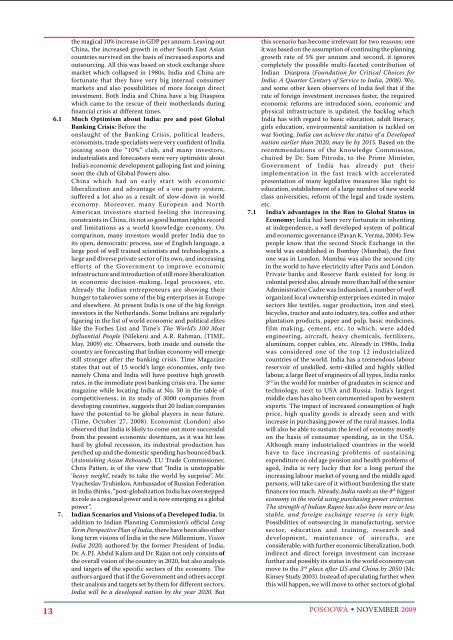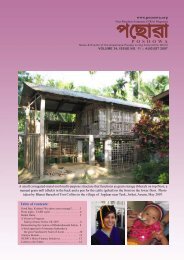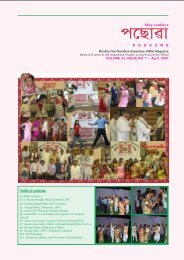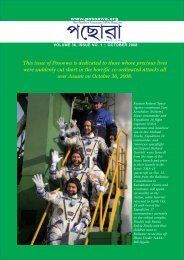India's youngest CEO Ranjan Das of SAP, India ... - Posoowa
India's youngest CEO Ranjan Das of SAP, India ... - Posoowa
India's youngest CEO Ranjan Das of SAP, India ... - Posoowa
Create successful ePaper yourself
Turn your PDF publications into a flip-book with our unique Google optimized e-Paper software.
13<br />
the magical 10% increase in GDP per annum. Leaving out<br />
China, the increased growth in other South East Asian<br />
countries survived on the basis <strong>of</strong> increased exports and<br />
outsourcing. All this was based on stock exchange share<br />
market which collapsed in 1980s, <strong>India</strong> and China are<br />
fortunate that they have very big internal consumer<br />
markets and also possibilities <strong>of</strong> more foreign direct<br />
investment. Both <strong>India</strong> and China have a big Diaspora<br />
which came to the rescue <strong>of</strong> their motherlands during<br />
financial crisis at different times.<br />
6.1 Much Optimism about <strong>India</strong>: pre and post Global<br />
Banking Crisis: Before the<br />
onslaught <strong>of</strong> the Banking Crisis, political leaders,<br />
economists, trade specialists were very confident <strong>of</strong> <strong>India</strong><br />
joining soon the “10%” club, and many investors,<br />
industrialists and forecasters were very optimistic about<br />
<strong>India</strong>’s economic development galloping fast and joining<br />
soon the club <strong>of</strong> Global Powers also.<br />
China which had an early start with economic<br />
liberalization and advantage <strong>of</strong> a one party system,<br />
suffered a lot also as a result <strong>of</strong> slow-down in world<br />
economy. Moreover, many European and North<br />
American investors started feeling the increasing<br />
constraints in China, its not so good human rights record<br />
and limitations as a world knowledge economy. On<br />
comparison, many investors would prefer <strong>India</strong> due to<br />
its open, democratic process, use <strong>of</strong> English language, a<br />
large pool <strong>of</strong> well trained scientists and technologists, a<br />
large and diverse private sector <strong>of</strong> its own, and increasing<br />
efforts <strong>of</strong> the Government to improve economic<br />
infrastructure and introduction <strong>of</strong> still more liberalization<br />
in economic decision-making, legal processes, etc.<br />
Already the <strong>India</strong>n entrepreneurs are showing their<br />
hunger to takeover some <strong>of</strong> the big enterprises in Europe<br />
and elsewhere. At present <strong>India</strong> is one <strong>of</strong> the big foreign<br />
investors in the Netherlands. Some <strong>India</strong>ns are regularly<br />
figuring in the list <strong>of</strong> world economic and political elites<br />
like the Forbes List and Time’s The World’s 100 Most<br />
Influential People (Nilekeni and A.R. Rahman, (TIME,<br />
May, 2009) etc. Observers, both inside and outside the<br />
country are forecasting that <strong>India</strong>n economy will emerge<br />
still stronger after the banking crisis. Time Magazine<br />
states that out <strong>of</strong> 15 world’s large economies, only two<br />
namely China and <strong>India</strong> will have positive high growth<br />
rates, in the immediate post banking crisis era. The same<br />
magazine while locating <strong>India</strong> at No. 50 in the table <strong>of</strong><br />
competitiveness, in its study <strong>of</strong> 3000 companies from<br />
developing countries, suggests that 20 <strong>India</strong>n companies<br />
have the potential to be global players in near future.<br />
(Time, October 27, 2008). Economist (London) also<br />
observed that <strong>India</strong> is likely to come out more successful<br />
from the present economic downturn, as it was hit less<br />
hard by global recession, its industrial production has<br />
perched up and the domestic spending has bounced back<br />
(Astonishing Asian Rebound). EU Trade Commissioner,<br />
Chris Patten, is <strong>of</strong> the view that “<strong>India</strong> is unstoppable<br />
‘heavy weight’, ready to take the world by surprise”. Mr.<br />
Vyacheslav Trubinkov, Ambassador <strong>of</strong> Russian Federation<br />
in <strong>India</strong> thinks, “post-globalization <strong>India</strong> has overstepped<br />
its role as a regional power and is now emerging as a global<br />
power”.<br />
7. <strong>India</strong>n Scenarios and Visions <strong>of</strong> a Developed <strong>India</strong>. In<br />
addition to <strong>India</strong>n Planning Commission’s <strong>of</strong>ficial Long<br />
Term Perspective Plan <strong>of</strong> <strong>India</strong>, there have been also other<br />
long term visions <strong>of</strong> <strong>India</strong> in the new Millennium. Vision<br />
<strong>India</strong> 2020, authored by the former President <strong>of</strong> <strong>India</strong>,<br />
Dr. A.P.J. Abdul Kalam and Dr. Rajan not only consists <strong>of</strong><br />
the overall vision <strong>of</strong> the country in 2020, but also analysis<br />
and targets <strong>of</strong> the specific sectors <strong>of</strong> the economy. The<br />
authors argued that if the Government and others accept<br />
their analysis and targets set by them for different sectors,<br />
<strong>India</strong> will be a developed nation by the year 2020. But<br />
this scenario has become irrelevant for two reasons: one<br />
it was based on the assumption <strong>of</strong> continuing the planning<br />
growth rate <strong>of</strong> 5% per annum and second, it ignores<br />
completely the possible multi-faceted contribution <strong>of</strong><br />
<strong>India</strong>n Diaspora (Foundation for Critical Choices for<br />
<strong>India</strong>: A Quarter Century <strong>of</strong> Service to <strong>India</strong>, 2008). We,<br />
and some other keen observers <strong>of</strong> <strong>India</strong> feel that if the<br />
rate <strong>of</strong> foreign investment increases faster, the required<br />
economic reforms are introduced soon, economic and<br />
physical infrastructure is updated, the backlog which<br />
<strong>India</strong> has with regard to basic education, adult literacy,<br />
girls education, environmental sanitation is tackled on<br />
war footing, <strong>India</strong> can achieve the status <strong>of</strong> a Developed<br />
nation earlier than 2020, may be by 2015. Based on the<br />
recommendations <strong>of</strong> the Knowledge Commission,<br />
chaired by Dr. Sam Pitroda, to the Prime Minister,<br />
Government <strong>of</strong> <strong>India</strong> has already put their<br />
implementation in the fast track with accelerated<br />
presentation <strong>of</strong> many legislative measures like right to<br />
education, establishment <strong>of</strong> a large number <strong>of</strong> new world<br />
class universities, reform <strong>of</strong> the legal and trade system,<br />
etc.<br />
7.1 <strong>India</strong>’s advantages in the Run to Global Status in<br />
Economy: <strong>India</strong> had been very fortunate in inheriting<br />
at independence, a well developed system <strong>of</strong> political<br />
and economic governance (Pavan K. Verma, 2004). Few<br />
people know that the second Stock Exchange in the<br />
world was established in Bombay (Mumbai), the first<br />
one was in London. Mumbai was also the second city<br />
in the world to have electricity after Paris and London.<br />
Private banks and Reserve Bank existed for long in<br />
colonial period also, already more than half <strong>of</strong> the senior<br />
Administrative Cadre was <strong>India</strong>nised, a number <strong>of</strong> well<br />
organized local ownership enterprises existed in major<br />
sectors like textiles, sugar production, iron and steel,<br />
bicycles, tractor and auto industry, tea, c<strong>of</strong>fee and other<br />
plantation products, paper and pulp, basic medicines,<br />
film making, cement, etc. to which, were added<br />
engineering, aircraft, heavy chemicals, fertilizers,<br />
aluminum, copper cables, etc. Already in 1980s, <strong>India</strong><br />
was considered one <strong>of</strong> the top 12 industrialized<br />
countries <strong>of</strong> the world. <strong>India</strong> has a tremendous labour<br />
reservoir <strong>of</strong> unskilled, semi-skilled and highly skilled<br />
labour, a large fleet <strong>of</strong> engineers <strong>of</strong> all types, <strong>India</strong> ranks<br />
3 rd in the world for number <strong>of</strong> graduates in science and<br />
technology, next to USA and Russia. <strong>India</strong>’s largest<br />
middle class has also been commented upon by western<br />
experts. The impact <strong>of</strong> increased consumption <strong>of</strong> high<br />
price, high quality goods is already seen and with<br />
increase in purchasing power <strong>of</strong> the rural masses, <strong>India</strong><br />
will also be able to sustain the level <strong>of</strong> economy mostly<br />
on the basis <strong>of</strong> consumer spending, as in the USA.<br />
Although many industrialized countries in the world<br />
have to face increasing problems <strong>of</strong> sustaining<br />
expenditure on old age pension and health problems <strong>of</strong><br />
aged, <strong>India</strong> is very lucky that for a long period the<br />
increasing labour market <strong>of</strong> young and the middle aged<br />
persons, will take care <strong>of</strong> it without burdening the state<br />
finances too much. Already, <strong>India</strong> ranks as the 4 th biggest<br />
economy in the world using purchasing power criterion.<br />
The strength <strong>of</strong> <strong>India</strong>n Rupee has also been more or less<br />
stable, and foreign exchange reserve is very high.<br />
Possibilities <strong>of</strong> outsourcing in manufacturing, service<br />
sector, education and training, research and<br />
development, maintenance <strong>of</strong> aircrafts, are<br />
considerable, with further economic liberalization, both<br />
indirect and direct foreign investment can increase<br />
further and possibly its status in the world economy can<br />
move to the 3 rd place after US and China by 2050 (Mc<br />
Kinsey Study 2003). Instead <strong>of</strong> speculating further when<br />
this will happen, we will move to other sectors <strong>of</strong> global<br />
POSOOWA • NOVEMBER 2009
















